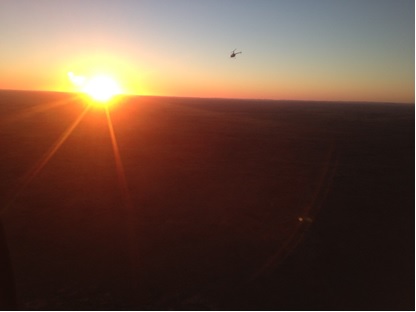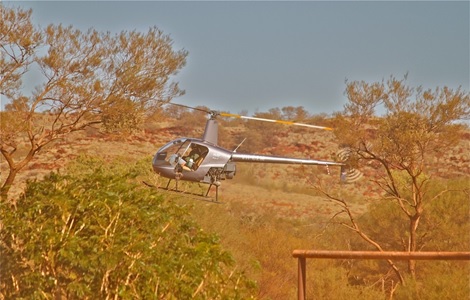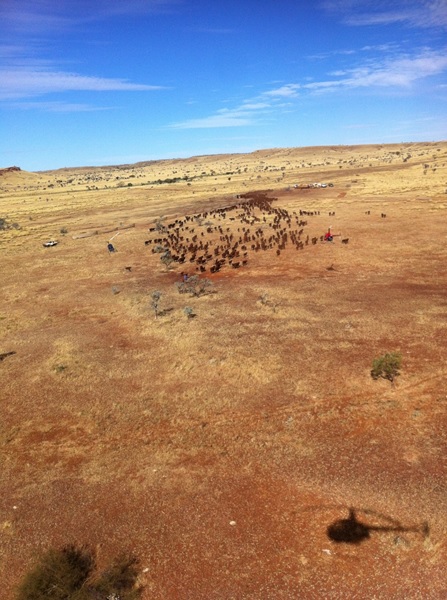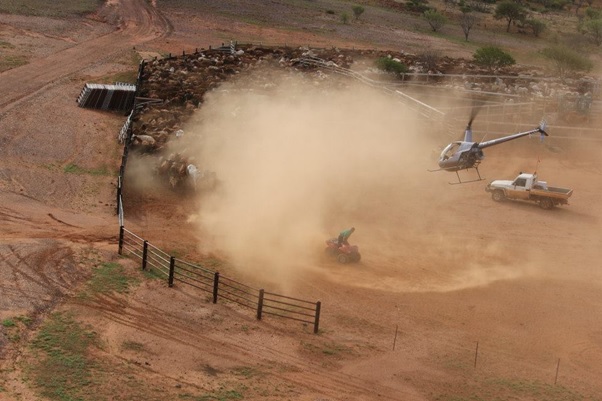A day in the life of a mustering pilot
Host: Fortescue Helicopters
Written by Weldon Percy – Operations Manager, Fortescue Helicopters.
 Heading to work at sunrise with Jennifer “Niffy” Paul from Williambury Helicopters (Photo Weldon Percy).
Heading to work at sunrise with Jennifer “Niffy” Paul from Williambury Helicopters (Photo Weldon Percy).
A day in the life of a mustering pilot generally starts the day before. Most of our work is a long way from home, at least over an hour’s flying time away, so we often go to jobs the night before so we are there early the next morning to start work. People not in the cattle industry often ask how come we always get up and start work so early, and there’s a few reasons. The main one is the welfare of the cattle and people we are working with. The earlier we start a given day means we can let cattle travel at their own pace as we are mustering them together. Early in the morning is cooler and often cattle will travel a given distance in half the time in the cool of the morning than they will during the heat of the day. If the day goes well and according to plan the cattle will get to yards earlier. If it doesn’t go according to plan and for some reason the cattle don’t muster well, starting early gives you the longest possible amount of time in a given day to slow down and work through any problems you’re having with cattle in a given area before continuing to muster. Starting early is just all round the best way to do things.

When we arrive at the station or stock camp for the night we normally refuel our helicopters and thoroughly check our machines over for the next day, mostly it’s easier to do this in the afternoon as it gives you a chance to look over your machine in the daylight and if any problems are found where the chopper can’t fly it gives you time to get on the phone and organise another helicopter to be delivered to you or do the job you were going to the next day. We probably spend about 60%-70% of our year out in stock camps in mustering season. Most Pilbara stations are around one million acres and it’s often too far from the homestead to the area that needs mustering so it’s much more practical to camp out.
After we have rolled out our swags and put our choppers to bed for the night we get a chance to catch up with the mustering crew, have dinner a couple of cold ones and relax. This also gives us a good opportunity to talk with the head stockman or manager about the next day’s work. Then it’s in bed early normally around 8.30-9pm to get a good rest before the next day.
Up in the dark around 4.30 in the morning we roll up our swags and briefly do final checks over the helicopter for the day. Then breakfast with mustering crew and make some lunch and we are ready to go right at daylight.
Depending on the customer, station crew, and mostly terrain depends on whether we “coacher” muster the cattle or just muster them another way. This is this is the first factor in planning how to do a day’s work. The second is water, although the two go hand in hand. Whether the cattle are living from man-made water such as bores windmills or solar pumps or if they living from waterholes and rivers.

For an example of what I mean, if we have a big mostly flat area with creeks rather than major rivers cattle will generally live off man-made waters. Cattle by instinct and by being handled properly generally will move towards water when they hear the noise of an aircraft, so in this type of terrain we gather cattle at waters for ground crew to walk along as “coachers”. In a paddock (fenced area) we normally would go all the way to the back or side of a paddock to bring cattle to water, but most of the country we work in has no fences or paddocks at all! In this terrain we work out the shape and size of an area around a “water” by the cattle pads (tracks where cattle walk) and cattle manure on the ground by how fresh they are where they go determines how far away from each water point we have to muster.
In terrain where we have big rivers, tall mountains, ridges, and generally less man made waters it becomes harder to walk cattle along as “coachers” and we often use rivers and creeks to bring cattle together and only work them as mob outside the creeks and rivers just before yarding up.
We bring cattle into the rivers with the helicopters and often the ground team will travel behind the cattle on the “tail” to keep them walking. The river banks and beds in this type of terrain are generally the easiest place for cattle to walk as they aren’t as rocky so the cattle normally string out and walk along with the crew following the tail of the mob. Then the helicopters will bring more cattle from other creeks and areas in front of the “tail” into the river.

In either type of terrain as the day goes along the mob (number of cattle) we are mustering gets bigger and bigger as the day goes by. Although a lot of Pilbara soil is richer in nutrients than further north, we do get less rain which generally means for the same area covered we run less cattle. With the ever increasing need for graziers to be cost efficient this often means we have two to three helicopters mustering at once rather than one or two. This probably sounds more expensive and that is correct! But it allows us to cover more area therefore more cattle are mustered in a day which makes for a shorter mustering season with less labour costs for the grazier.
So depending on how our day starts out and which way we muster our day is pretty predictable to a point. When we are coacher mustering we often get to stop at the bore with ground crew and while a few of them are holding the mob we get to land and have lunch and boil the billy, which gives us a break. Other times we keep flying all day except for stops for fuel which is about every three hours or so, and the occasional brief stop for a sandwich or a toilet break.
The first part of the day is normally most enjoyable from a flying perspective as the air is cool and not so turbulent. Throughout the middle of the day often is the most tiring as it can be very warm and thermals and wind often make for a rough ride. The end of the day or yarding up is the most rewarding to see your days’ work accomplished and a mob of cattle in the yard.
Once we get to the yards and the crew have the gates closed we generally land and briefly talk to the head stockman or manager before fuelling up and heading off to the next station for the next day, and we start all over again.
And that’s a day in the life of a mustering pilot at Fortescue Helicopters . . . . . .

So you want to be a mustering pilot? Check out this post as Weldon tells you all you need to know to get up in the sky – how much is costs, how many hours, what the exams are like . . . ! http://www.centralstation.net.au/so-you-want-to-be-a-mustering-pilot/
